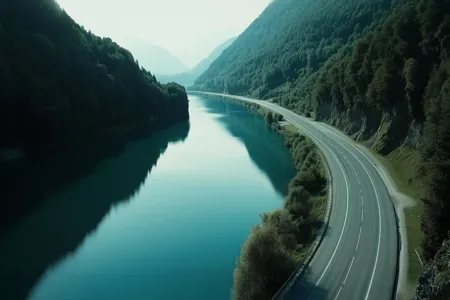Toll roads in Slovenia
In Slovenia, tolls are mandatory on all motorways (avtoceste A) and expressways (hitre ceste H). A valid digital vignette (e-vignette) is required for these roads.
Some motorways are also part of the European road network and carry an E designation in addition to their Slovenian code. For example, the A1 is the backbone of Slovenia’s motorway network and is also marked as E57, E59, E61 and E70.
Slovenian motorways requiring a vignette
All motorways (A roads) in Slovenia require a valid digital vignette. These are the main highways that connect the country’s major cities and form part of the European transport corridors. Without a vignette, you cannot legally drive on these routes, and checks are frequent.
A1 (E57, E59, E70) between Šentilj, Maribor, Celje, Ljubljana, Postojna and Koper.
A2 (E61, E70) between Karawanks Tunnel (separate toll), Kranj, Ljubljana, Novo mesto, Brežice and Obrežje.
A3 (E61, E70) between Divača and Fernetiči.
A4 (E59) between Slivnica, Hajdina, Draženci and Gruškovje.
A5 (E653) between Dragučova A1, Beltinci, Murska Sobota and Pince.
Slovenian expressways requiring a vignette
Besides motorways, certain expressways (hitre ceste H roads) also fall under the vignette system. These roads are usually shorter routes but still part of the national toll network. A vignette is mandatory here as well, even though traffic often feels more regional than international.
H3 between A1 and A2 on the Ljubljana ring road.
H4 between Razdrto A1, Nanos, Ajdovščina and Vrtojba.
H5 between Škofije, Dekani, Koper H6 and Dragonja.
H6 between Koper H5 and Lucija.
H7 between Črni dol A5 and Dolga vas.
Toll-free sections and exceptions
H2 between Maribor West and Tezno.
H6 between Koper and Lucija.
A2 between Jesenice and Vrba.
In addition, the Karawanks Tunnel (A2), which connects Slovenia with Austria, is not covered by the vignette system. Instead, drivers must pay a separate toll fee to use the tunnel.
The toll can be paid directly at the toll station located before entering the tunnel. Payment is possible in cash (EUR) or with credit and debit cards. Unlike digital vignettes, this fee is collected as a one-time charge per passage.



